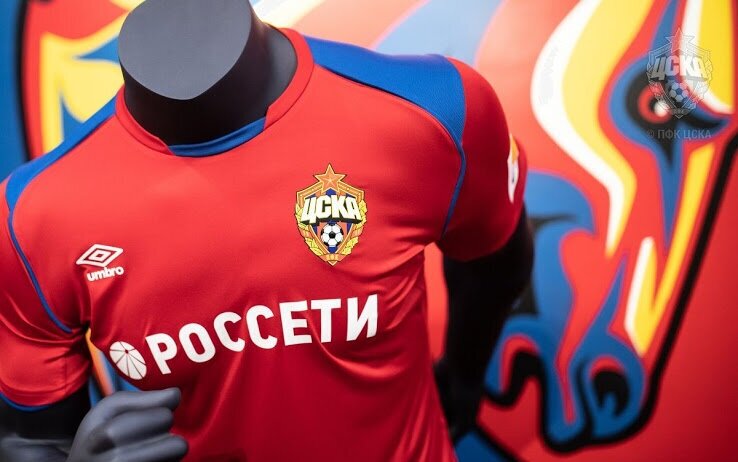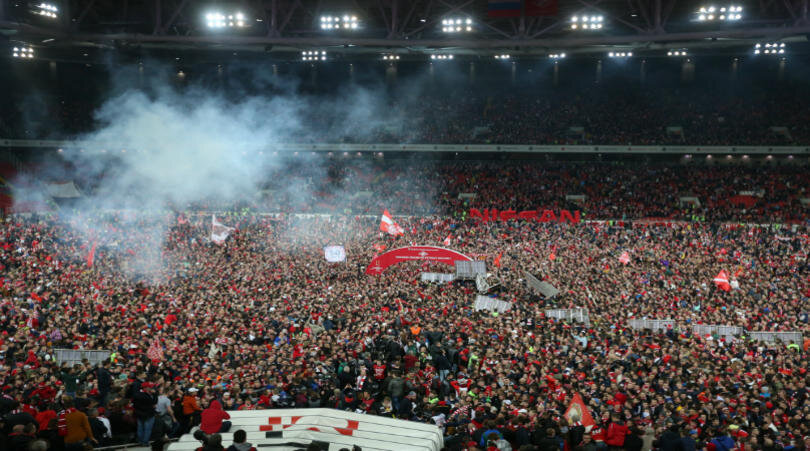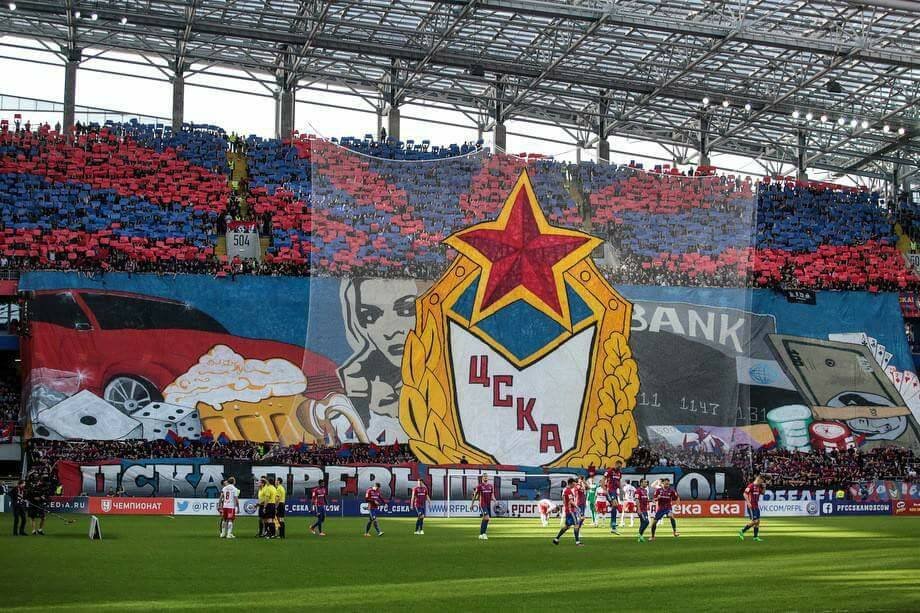The Soviet Birth of the Five Moscow Teams
Pyro during a Spartak-CSKA match in 2016 | Photo Credit
Moscow is a football-crazy city.
Falling second only to London having six Premier League teams (at the time of writing), Moscow as a city boasts four top-flight teams playing in the top division of the country, more than anywhere else across Europe’s eight top-ranked coefficient leagues.
However the London clubs that have climbed their way to the top table in England pale in comparison to the baptism of fire which were the circumstances surrounding the origins of these Moscow teams.
The period following the 1917 Revolution & the battle for Communism in Russia was a tumultuous time in the country’s history. However, with these mass changes in society came the birth of five football teams in Moscow, each with very distinctive backgrounds, societal & governmental ties.
History of CSKA Moscow
If we begin chronologically, the first team to emerge in Moscow was actually before the 1917 Revolution - CSKA Moscow in 1911.
Fun fact; when pronouncing CSKA Moscow it is not the English pronunciation of the letters “C-S-K-A”, it is pronounced “Ssss-Kah”.
Their beginning comes hand-in-hand with the Russian Army, with CSKA roughly translating into English as; “Central Sports Club of the Army”. Although the club is no longer directly connected with the Russian military, the red star that is synonymous with the Russian army can still be seen in a prominent position on the club’s crest. They were essentially the club of the Soviet Red Army.
The red star clearly visible on CSKA’s crest | Photo Credit
CSKA are now completely privately owned however & have become one of the more dominant teams in Russian football, becoming the first Russian team to win a European Cup in 2005.
History of Lokomotiv Moscow
Post the 1917 Revolution the next team to emerge in Moscow was Lokomotiv Moscow. As the name might suggest this club was founded by members of the Russian Ministry for Transport, with railwaymen being central to the club’s inception in 1922.
The club’s name was changed a few times but since 1936 Lokomotiv has stuck & as with CSKA, the club’s link to its roots can still be seen in today’s crest with a green train clearly visible.
The Russian Railways is the biggest employer in the country, so Lokomotiv are looked upon quite favourably by many football fans in Russia, in essence they are many Russians’ “second team”.
Also owing to the fact that Lokomotiv is a railway club, a large & far-reaching industry & employer, they have had a large number of non-Russians at the club. They are seen as a more progressive club in terms of inclusivity than all of their city neighbours.
Like CSKA, Lokomotiv are tied for the most consecutive seasons in the Russian Premier League.
History of Spartak Moscow
In 1922 another new Moscow team emerged with arguably the most interesting of inception stories. On the back of the Trade Union movement & named after a famous gladiator (Spartacus) who led an uprising against the Roman Empire, Spartak Moscow was born.
Known as the “people’s club” Spartak Moscow had its founding member Nikolai Starostin along with his three brothers arrested during the Soviet Union’s ‘Great Purge’ in the 1930s. He was eventually released on the condition of accepting a request from Josef Stalin’s son Vasily, to coach the Soviet Air Force’s football team.
Despite a politically crippling start, Spartak have gone on to be the most successful team in Russian history with their crest displaying four stars, each signifying a win of five Russian championships.
Spartak fans flood onto the pitch following the club’s most recent league success in 2017 | Photo Credit
Spartak Moscow are also the most supported club in Moscow & indeed all of Russia, with their fans vastly outnumbering all of their city neighbours.
History of Dynamo Moscow
1923 saw a fourth Moscow team rise-up & again coming from a different governmental organisation; the Ministry of Internal Affairs, i.e. the police. Russia’s infamous secret police established a team of their own, forming what we know today as Dynamo Moscow.
They have experienced mixed success on the pitch throughout their history, earning two stars on their crest following their eleven Russian Championship wins, but also suffering relegation for the first time in their history in 2016.
A 3-0 loss to Zenit in 2016 confirmed Dynamo’s relegation for the first time in their 93-year history | Photo Credit
They have since been promoted back to the Russian Premier League to complete the quartet of Moscow teams competing domestically at the highest level.
Despite the police-related inception of Dynamo, they are now majority controlled by the government-owned VTB Bank.
It is also unanimously agreed upon that Dynamo has the best youth academy & infrastructure system, not just in Moscow, but in all of Russia.
History of Torpedo Moscow
“The Black Sheep”. “The Bridesmaid”. The fifth & final Moscow team arrived in 1924 & Torpedo Moscow are most definitely the least-known of the Moscow teams. This time it was the turn of the car factory workers to establish a football team, celebrated to this day with the image of a car on the club’s crest.
In terms of silverware, Torpedo are the least successful of the Moscow clubs & have spent most of their recent history languishing between Russia’s second & third tiers. They also have the smallest fan base in the city, as well as the smallest stadium with a capacity of under 15,000.
If you are looking for an underdog in this story, look no further than Torpedo Moscow.
Moscow Rivalries, the Ultras & Hooligan Scene
All five teams are known internationally for having hugely passionate fans, in particular their ultras groups.
The rivalry seems to run most deeply between Spartak & Dynamo, which goes hand-in-hand with the general human history of common working-class people & their relationship with the police.
Whereas more recently, the CSKA-Spartak rivalry has grown more intense owing to both clubs’ domestic success & regularly competing for Russian Premier League titles.
A TIFO prior to a CSKA-Spartak derby | Photo Credit
On the other hand, Dynamo & CSKA’s fans seem to tolerate each other a lot more than the others. To call it a fan friendship would be too much of a stretch, but it is similar to a relationship between the police & the military perhaps?
‘Red-Blue Warriors’ (CSKA), ‘Fratria’ (Spartak), ‘Red-White Djigits’ (Lokomotiv), ‘Ultras Dynamo’ (Dynamo) & ‘Troublemakers’ (Torpedo), are all examples of some of the ultras groups that have become world-renowned for their passionate support, nationalistic & sometimes racist behaviour, as well as their willingness & appetite for physical altercations to defend the honour & reputation of the club & the city.
This is generally the image people have of Russian football fans | Photo Credit
Passionately nationalistic or racist? Neo-nazi or right-wing political? Violent thugs or well trained fighters? The answer to many of these questions are generally based on a personal point of view.
What cannot be denied is the well-planned, colourful, artistic, pyrotechnic & passionate support that these Moscow teams are given by the fans who follow them across the vast expanses of Russia & beyond, is something to be admired.
Football groundhopping weekenders are becoming increasingly popular, particularly across Europe. While Moscow might not be as easily accessible or as cheap as getting to London, Berlin, Madrid or other popular European groundhopping cities, Moscow is as rich a footballing city, steeped in history & culture. Anyone who considers themselves a keen groundhopper must have Moscow high on their list.








